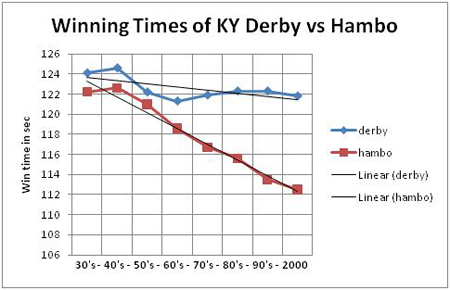By Bill Pressey Thoroedge
Equine Performance
The fact is that harness racing times have improved markedly over the past 70+ years, while Thoroughbred times have lagged well behind.
To keep things simple, I decided to use the winning times in the Kentucky Derby and the Hambletonian – the two feature races for each discipline. I converted winning times to total seconds and rounded off to the nearest whole number. Each decade’s time was an average of each of the 10 years included within:

Both races feature a landmark effort to break the 2:00 barrier; first accomplished in the Derby by the immortal Secretariat in 1973, with the corresponding harness racing effort coming from Emily’s Pride in 1958 – both carding a 1:59 and change.
From the above chart, starting in 1930 Standardbreds have improved winning Hambo times by 7.9%, while Thoroughbreds of the same period have improved Derby winning times by just 1.8%. If you start analyzing the data at the time of the breaking of the magic 2:00 threshold the differences are even more striking – 7.0% for trotters vs. an imperceptible 0.08% for Thoroughbreds.
So, we have seen a roughly 500% greater improvement in Hambo winners versus Derby champs. Those of you who have read my work before know of my interest in the training aspect of the game, so let’s take a look at all the variables that may hold some answers to the above discrepancy.
Training and racing frequency
Thoroughbreds these days are lucky to get 6 starts per year on average, yet Standardbreds often race weekly – even needing to qualify prior to big races. Thoroughbreds, taking into account a few weeks off from speedwork after a race, may see 12 sec/furlong paces for a half mile every 10-14 days. Standardbreds train in an interval fashion, working many miles each week at race pace of 14 sec/furlong.
Use of technology
Thoroughbred trainers are avid users of the stopwatch, and sometimes the scales. Standardbred practicioners have utilized heart rate monitors, lactate analyzers, resistance carts, etc. for long before I entered the picture in 2008.
The first Standardbred trainer I met was training a Thoroughbred here at Churchill Downs, a former $5,000 claimer. After a few interval sessions at 1 mile with the HR/GPS monitor, his horse went on to win his next two route races by a total of 29 lengths – and was eventually claimed away for $50,000. Now with a new trainer and using the same old methods, that horse has done very little since – and at last glance was eligible to be claimed again for $15,000.
A Lexington-based equine rehab center with a modern hyperbaric chamber reports that after harness races at the Red Mile, she gets a line of vans with sound candidates for post race treatment in order to enhance recovery. Despite being closer to Keeneland, Thoroughbreds never make the trip unless a horse is injured and in need of therapy.
Drugs, namely Lasix and Bute
Lasix became raceday legal back in the 80’s for Thoroughbred racing, and starts per career numbers have fallen ever since, while Derby winning times have remained stagnant. The Hambletonian outlawed raceday Lasix and Bute in the early 90’s, yet times have continued to improve at the same rate. Hambo competitors are allowed raceday drugs throughout the year, but not during this classic – yet few bleed and performance doesn’t suffer. The banning of drugs was purely a political move of course, but the results are still interesting from a physiological standpoint.
Pre-race warm up
Nonexistent for most Thoroughbreds, the pre race routine consists mainly of walking in the post parade followed by a gentle trot next to the pony before entering the gate. Standardbreds often warm up a few miles prior to completion, with several furlongs of near race-pace efforts.
Other factors
Racing equipment has improved in both sports, but certainly the lighter sulkies present in modern day Hambletonian racing contribute to some of the improvements. Manufacturers of such equipment claim a 2 second benefit, which is only a small portion of the overall improvement seen in the breed.
All Thoroughbreds start from a standstill, while trotters get a rolling gate, which is much easier physically on the Hambo competitors. Thoroughbreds also travel a bit faster than the trotters, which can cause more skeletal and soft tissue problems.
In US racing, most Thoroughbreds have to start quickly and come home dead tired, while trotters actually often complete final quarters faster than the first ones, what is termed a ‘negative split.’
Add these factors together and you can see that Thoroughbred racing is probably tougher on the equine athletes, which can explain a higher injury rate – but not necessarily a lack of performance improvement.
Parting shot
I have one client, a self made millionaire here in the US, who insists to me that all big time TB trainers have a very good grasp of equine exercise physiology – but the numbers just don’t bear that out.
Somewhere, someday a Thoroughbred owner/trainer is going to learn from the training methods of the Standardbred guys, instead of the Thoroughbred elite, and make history with a champion coming from a modest pedigree. Only then will everyone else copy his practices and we’ll see Derby winning times in the mid 1:50’s on a consistent basis.




